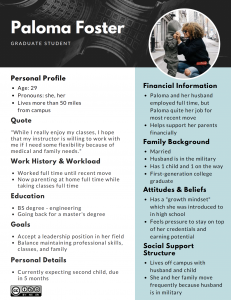A student persona is a summary of a specific type of student. This persona represents archetypes NOT stereotypes of a broader student segment or group. A student persona summarizes who the student users are and why they are using the learning system, as well as what behaviors, assumptions, and expectations determine their view of the learning system.
Why Create Student Personas?
There are many reasons why instructors and instructional designers and developers create and use student personas, such as:
- To represent the major needs of the key student user groups.
- To provide a reliable and accurate representation of your targeted student audience.
- To enable you to focus on a manageable and memorable group of students.
- To help you create different designs for different kinds of students and to tailor the design to meet the needs of the most important student user groups.
- To inform on the functionality of the learning system, uncover gaps in instructional design and development, or highlight new ways to deliver learning.
What Makes Up a Student Persona?
Like all personas, student personas generally include several key pieces of information, which are outlined on usability.gov
Here is an example of a student persona that I created for an online Intro to Permaculture MOOC that includes the essential elements of a persona.
 Description of the user research conducted to create the student persona:
Description of the user research conducted to create the student persona:
Student user research was conducted through an online Welcome survey that was embedded in the online course. As in all persona creations, user research should be conducted and the collected data should be used in order to ensure accurate representations of your users. Student user research can be conducted online or face-to-face through student surveys, interviews, or observations.
Student Persona Example (Enlarged View)
How Are Student Personas Used?
More than one student persona (3-5 student personas) should be used for an instructional development project from the analysis phase to the design, development, implementation and evaluation. As such, these student personas can be used in numerous ways.
Smashing Magazine, A Closer Look at Personas – What They Are and How They Work, discusses some of the general uses of personas:
- Build empathy
- Develop focus
- Communicate and form consensus
- Make and defend decisions
- Measure effectiveness
Resources
While there is no one way to create and use a persona, there are plenty of examples, free templates, and instructional videos and readings available to help you get started to create personas of the students that you serve and to use them in your instructional developments. These resources are available through the following links.
Examples
Templates
Fake Crow Free Persona Template
Persona Core Poster Template | PDF
Video
How to Create UX Personas (3:01)
(Note: This video talks about service design for customers, but for student personas, you will want to keep in mind that the students and learners are the customers)
Readings
Personas by usability.gov
A Closer Look at Personas – What They Are and How They Work by Smashing Magazine
This is a re-publish of a prior blog post that is quite popular and we wanted to bring it to the top of the blog again. Thank you to our original author: Rebecca Pietrowski


